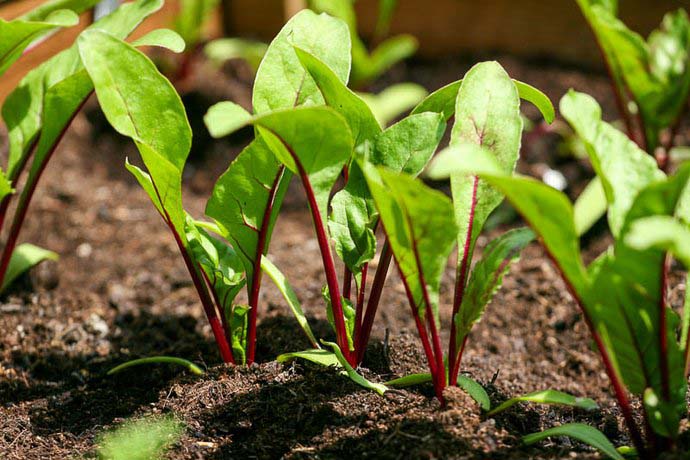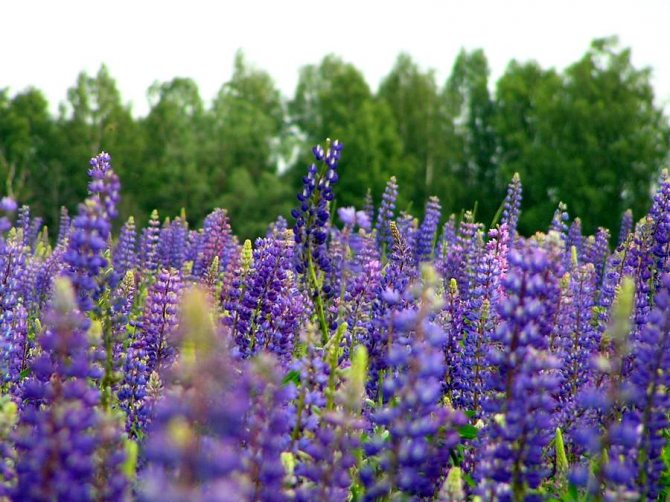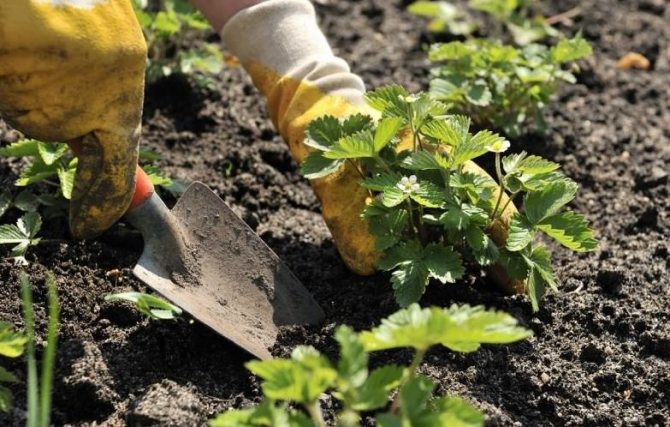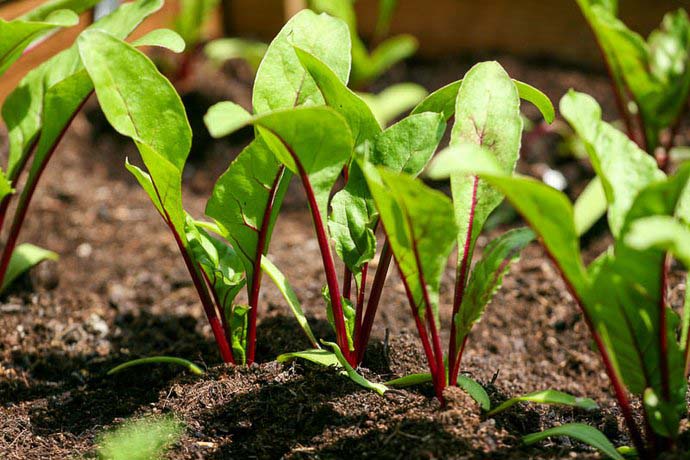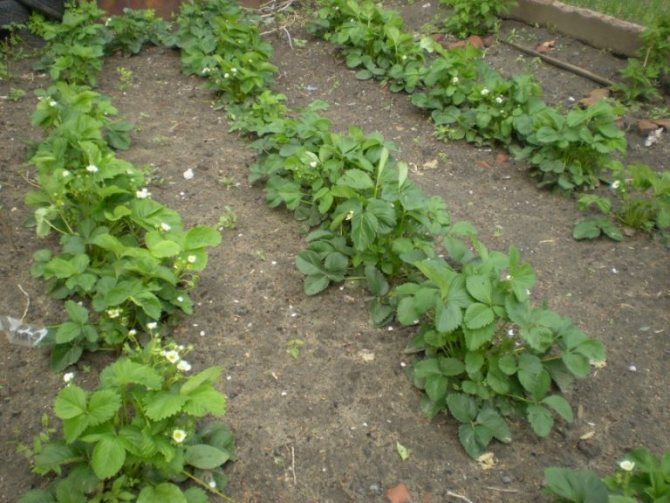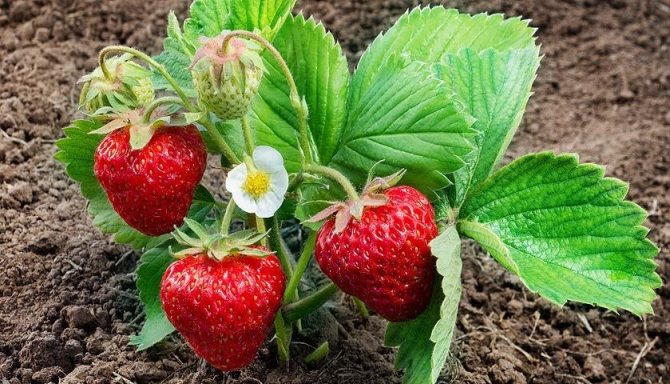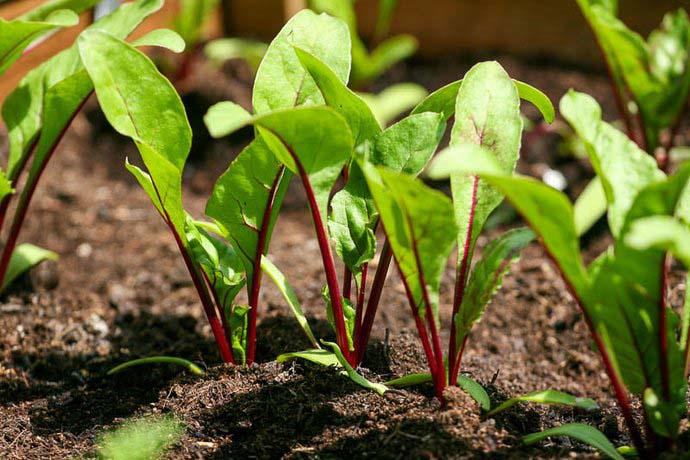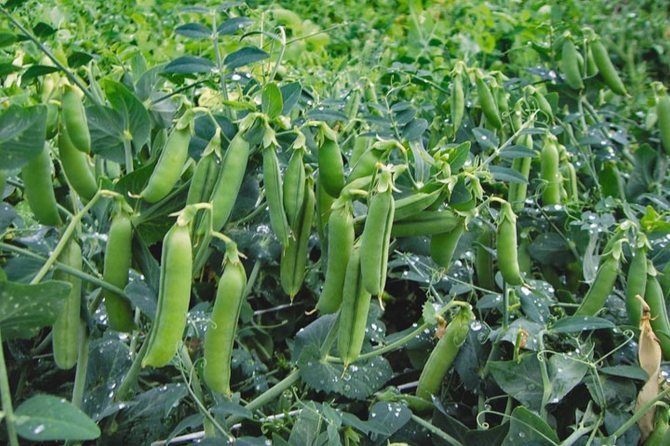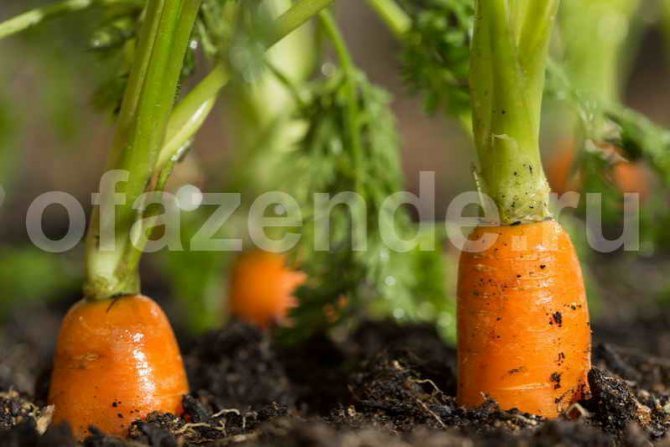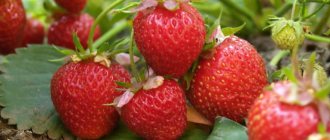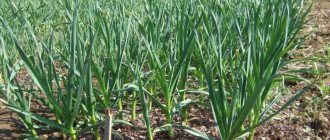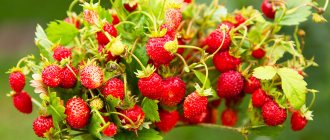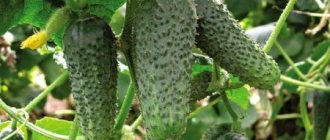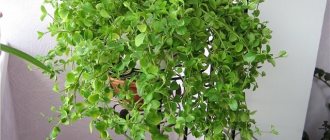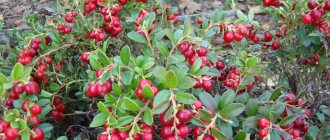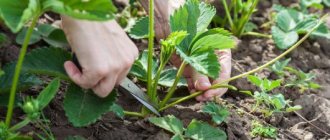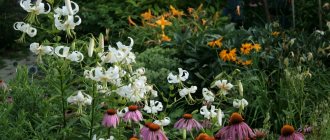Observance of the correct crop rotation in the garden helps to get good yields of vegetable and berry crops. If it is observed, a minimum of chemistry is required to maintain soil fertility and health. Crop rotation is of particular importance for crops that have been growing in one place for many years, including strawberries.
The culture gives good yields in one place for 3-5 years, then the quality of the berries deteriorates every year - they become smaller. Usually every 4 years the strawberry plantation needs to be moved to a new location. Most summer residents have small gardens, so the question is: what to plant after strawberries, the choice of a new place for it is always relevant.
For a new strawberry plantation, important conditions will be:
- location;
- the mechanical composition of the soil and the degree of fertility;
- predecessors.
Crop rotation tasks
The alternation of crops is necessary to increase soil fertility, prevent the development of diseases and the reproduction of pests. The correct combination of crops, selection of the best predecessors, determination of the optimal growth period for strawberries in one place will lead to an increase in the amount of yield and an improvement in the taste of berries.
Planting as predecessors of legumes and cereals is of great importance in the cultivation of strawberries. They serve as green manure, contributing to the formation of a fine crumbly structure, accumulating a large amount of organic matter in the soil, enriching the poor soil with nitrogen.
It is not recommended to grow strawberries on one piece of land for more than five years. And this means that you need to plant one new bed every year, after five years it is dug up.
Some gardeners manage to get a good harvest of berries from 6-7 year old beds. This happens, some varieties of strawberries are long-livers. But it is better to plant it in another place in order to restore the fertility of the soil, and prevent the spread of pests among berry crops.
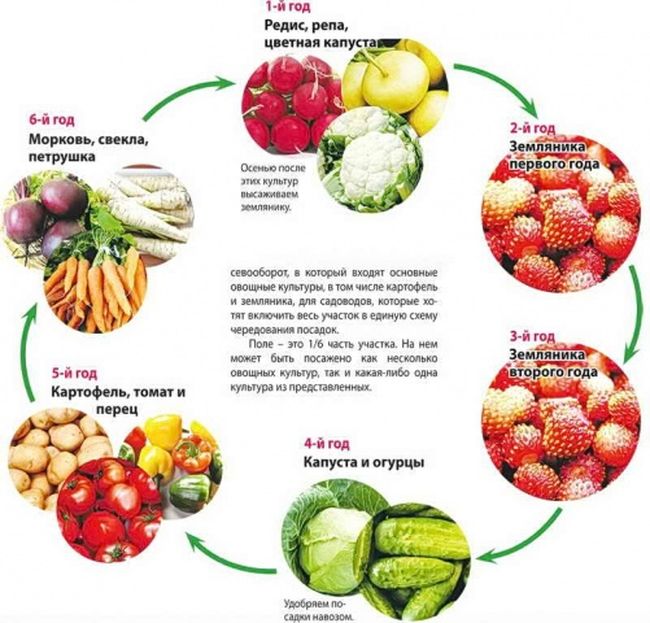
What to plant in a strawberry garden next year
Every experienced gardener knows that in order to obtain a rich harvest, after a couple of three years, the plants in the beds should be changed. This is a constant rule of good crop rotation.
A berry like strawberry is able to pump out useful substances from the soil, therefore, after three years, the berry should be removed from the garden to a new place. What to do with the vacant strawberry bed?


General transplant rules
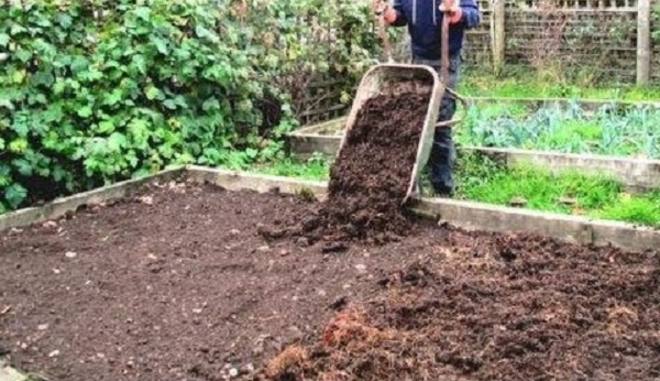

Among summer residents, in addition to general rules for caring for plants, there is a set of rules for crop rotation. If you grow one crop in one place for a long time, then there will be little sense from it. The fact is that each type of culture produces only its own toxins. Which can be detrimental to subsequent plants. And a number of pathogenic bacteria further reduce the yield of certain crops every year. Do not forget about the need for nutrients for crops, then each land plot is depleted in its own way.
The question of which crops it is better to plant strawberries after becomes clearer if you know the general rules of crop rotation:
- Any crops should not be grown in the same area for more than 5 years.
- The plant will germinate better in other beds without returning to its original place.
- Before planting, you need to remember the mineral fertilizers that were used for a particular crop. Some summer residents keep special diaries. A number of minerals are good for several crops and can be fatal for others.
A number of gardeners advise to allocate a separate area on the site for growing the so-called green manure. These are plants that aid in the cultivation of certain crops as useful organic fertilizers.
How to Recover Depleted Ground After Strawberries
Strawberries take away all the useful components from the soil, so the most rational solution would be not to grow anything for one year in the place where strawberries used to grow. The garden bed needs rest and restoration.
How to quickly and efficiently restore soil
On the former strawberry garden, a "fallow field" is set up - the gardener cleans the soil from weeds and dugs it up, adding the necessary fertilizers.
The garden bed can be sown with grain crops in the spring, and dug up along with the overgrown grass in the summer. Digging is carried out, as a rule, in late June or early July.
These measures will saturate the soil with nitrogen and organic fertilizers. The humus level in the ground will also increase significantly.
Such soil restoration takes a lot of time and effort, but if you decide to grow melons and gourds in a strawberry garden, then you can quickly and effectively get rid of old strawberries:
- Old and unnecessary strawberry bushes that can no longer bear fruit are abundantly sprinkled with leaves and humus.
- Each bush is watered from a watering can with a water-based solution Baikal EM 1.
- The garden bed or individual bushes are covered with a dense black film.
- Melons can be planted directly on top of the film, having made cuts in it of the required size.
- This will help avoid unnecessary digging. The strawberries will process themselves for fertilization. And vegetables, in its place, will grow tasty and large.
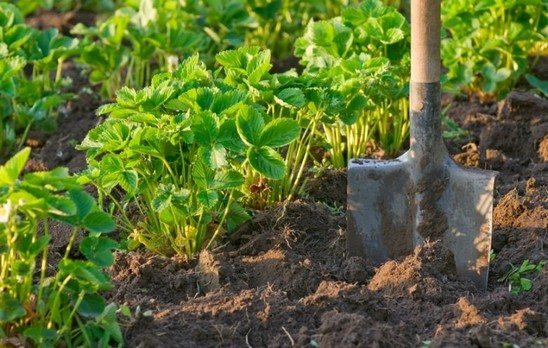

The most suitable conditions for growing strawberries
This plant is relatively unpretentious, but in order to get large yields of tasty sweet fruits from strawberry bushes, when planting, you need to take into account the requirements of the crop for growing conditions.
- The timing of disembarkation should correspond to the region of the country: in areas with a warm climate, this event is held in the spring, with a cold one - from mid-summer to early autumn. The soil must be warmed up to at least + 8 ° C.
- The landing site should be open and well lit during the day. When planting varieties with small fruits, partial shade is allowed.
- The groundwater level should be no higher than 1 m from the ground surface.
- The optimum soil acidity is 5.5 ... 6.5.
- Strawberries respond well to soil fertility, in the first 2 years after planting they like the introduction of organic fertilizers.
In addition to the above rules, when planting strawberry seedlings, the rules of crop rotation are taken into account.
Grass crop rotation for strawberries
To organize the crop rotation of strawberries on your site, use the experience of dividing the occupied area into 6 parts. Occupy one of them annually with green manure plants. Vika is especially effective:
- add organic fertilizing in the spring;
- dig deep into the selected part of the earth;
- level the area;
- sow green manure, about 5 cm deep in a proportion of 17 g / 1 sq. m;
- in the summer, as soon as the plant blooms, mow it;
- leave to dry on the ground for several days, then dig into the ground;
- level the area again and sow winter rye at the rate of 13 g / 1 sq. m;
- in November, mow the rye and thoroughly dig up part of the site.
In the spring, plant potatoes in the usual way. From the third season, strawberries can grow in this place. A two-year restoration allows you to take 4 out of 6 parts of the plot with strawberries, and grow useful and fruitful crops on the rest.
Strawberries in the garden are demanding to care for.The correct agricultural technology for land restoration will help you always have a tasty berry harvest.
Plants - siderates
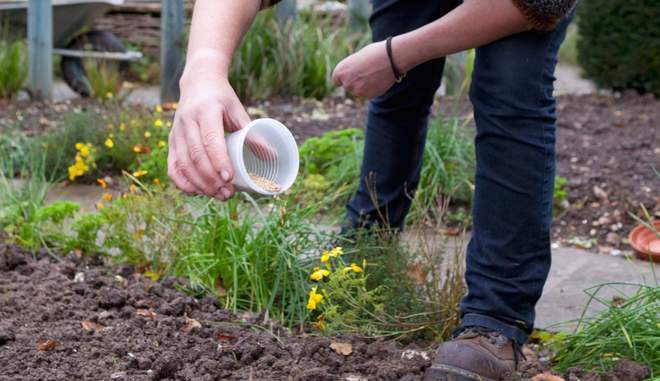

Some summer residents, a couple of years before planting, the selected area is specially sown with so-called green manure. With the help of green helpers, you can stock up on organic fertilizers and enrich the composition of the soil:
- With the help of a plant such as rapeseed, you can increase the amount of phosphorus in the soil.
- White mustard is able to enrich the soil with humus.
- With the help of vetch and lupine roots, you can enrich the earth with nitrogen compounds.
- Buckwheat, like rapeseed, will give the soil the necessary phosphorus, as well as a number of other useful compounds.
- If the acidity of the soil is increased, the situation can be corrected with the help of phacelia.
- If parasites such as hookworms are present, calendula, oats, and marigolds can help neutralize the problem.
After flowering, some summer residents do not throw out green manure, and bury the flowers in the ground for better results.
Crop rotation rules
If you carefully study the issue of the correct crop rotation of strawberries, it is easy to notice that not only the type of the planted crop is important, but also the sequence of its placement on the site.
An approximate scheme for the optimal planting of plants by years may be as follows:
| Growing year (in order) | Variety of cultivated crops |
| First | Vegetables: radish, radish, early cauliflower, young strawberries |
| Second | 1st year strawberry |
| The third | 2nd year strawberry |
| Fourth | Cucumbers and cauliflower |
| Fifth | Root vegetables: radish, radish, carrot |
| Sixth | Carrots, beets, parsley (other greens) |
In addition, whatever is grown on the selected site to this berry, before carrying out planting activities, it is worth fertilizing the soil again, disinfecting the garden bed with a weak solution of potassium permanganate and fluffing up the soil, while removing all weeds.
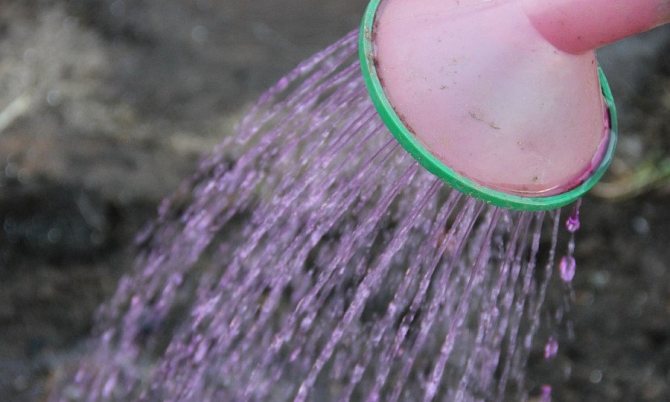

Good and bad neighbors for garlic
The substances secreted by garlic have a beneficial effect on some vegetable and flower crops:
- the garlic aroma scares off the Colorado potato beetle - the main pest of potatoes;
- the bactericidal properties of the plant prevent the appearance of late blight, rust on tomatoes and peppers;
- phytoncides inhibit pathogenic bacteria, fungal spores in the beds with salads, herbs;
- protect carrots, currants, raspberries, strawberries from the attack of carrot flies, slugs;
- prevent the spread of fungal diseases and aphids on asters, roses, gladioli.
Good neighbors for garlic planting are calendula, chicory. They scare off a dangerous pest - the onion fly. Horseradish contributes to an increased concentration of ascorbic acid in the leaves of the culture. Tomato bushes growing nearby create a natural defense of the plant against the spread of scab. The recommended distance between neighbors is 50-60 cm.
Do not plant representatives of the legume family (peas, lentils, beans), cabbage, parsnips next to garlic. The yield of the listed vegetables will decrease. Onions and spicy herbs inhibit the growth of garlic heads. As a result of joint planting, the cloves grow small, do not have time to mature in due time.
Unwanted strawberry precursors when planting


Asking the question of what is best to plant strawberries in the fall and at any other time, it is important to consider not only the recommended predecessors. There are a number of plants, after which it is categorically not recommended to plant herbs. The main representatives of unwanted crops are.
- It is undesirable to plant strawberries after cabbage due to the consumption of a large amount of nitrogen by the crop. Which is also important for strawberries.
- Pumpkin can also significantly reduce the characteristics of the soil.
- Sunflower significantly reduces the nitrogen availability in the soil, as does cabbage.
- Jerusalem artichoke is a plant whose roots go deep into the ground.They are difficult to dig up, and if they are of poor quality, they will destroy the root system.
- Buttercups secrete substances that are poisonous in nature.
If there is no choice and you have to plant the berries after unwanted predecessors, you will have to add a significant amount of additional organic and mineral fertilizers. You can restore the soil faster with the help of siderates. In addition, some vegetables have a number of similar diseases that can infect the soil:
- Planting strawberries after potatoes is undesirable. After tomatoes, planting berries is also undesirable. These crops have a common disease called late blight. When wondering whether it is possible to plant strawberries after potatoes, it is also important to remember about a common pest - the wireworm, with which potatoes often infect the soil.
- If, after a tomato, the soil is infected with specific types of pests, then after zucchini and cucumbers, diseases such as gray rot and slugs can be found on the berry.
While the negative effects of any crop can be neutralized with resistant strawberry varieties, it is best to naturally avoid the aforementioned precursors.
How strawberries affect the soil. Reconstructive procedures
Garden strawberries and strawberries are extremely healthy and tasty berries. It is not surprising that the vast majority of summer residents and gardeners grow them. On the site, these plants are very capricious to care and consume a large amount of nutrients from the soil.
Strawberries do not grow effectively in one place for more than 3 seasons. Then the berries become smaller, and their yield decreases.
In the fall, the bushes are carefully transplanted to new beds. The berry can be returned to its original place no earlier than 6 years after transplantation. At the same time, the owners of the site are faced with the question: what to do with the empty land? In any case, in the fall, you need to do the following:
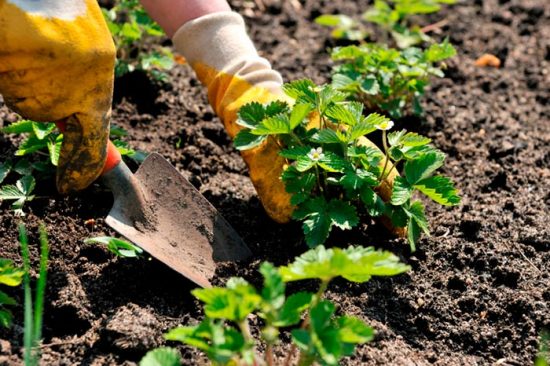

- Apply a complex of organic and mineral fertilizers.
- Dig up the beds thoroughly several times.
Advice. It is better to pour mineral mixtures into prepared furrows a few days before starting work.
Useful substances alone cannot fix the damage to the earth. The fact is that, in addition to depletion, the structure and density of the soil change in the negative direction. Sometimes gardeners decide to leave the site free, without planting anything on it. During the season, biochemical processes and additional fertilizing will restore the fertility and structure of the soil, form a zeolite part and accumulate humus.
Another way is to sow green manure. Suitable:
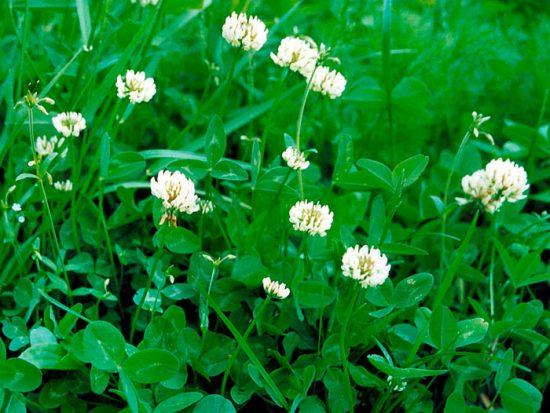

- alfalfa, vetch-oat plants;
- mustard white;
- rapeseed, etc.
Green manure crops should be dug up and left in the ground. They will act as an organic fertilizer.
What crops can be planted after strawberries


You can plant several crops after strawberries next year. Young seedlings of any plant species should not be planted after strawberries the next year due to depletion of the soil. After the gardener has figured out the question of how to plant strawberries in the fall and at any time of the year, it is important to know the desired neighbors and followers for the berry.
The list of what can be planted after strawberries includes the following types of crops, which can also play the role of good and useful neighbors:
- in the presence of snails and slugs, parsley will help;
- garlic will help prevent late blight;
- disinfection will be more effective with onions and garlic;
- representatives of legumes will make the soil looser and supply it with nitrogenous compounds;
- in the garden bed after strawberries, you can neutralize the non-method with the help of marigolds.
When wondering what to plant after strawberries, you can pay attention to carrots and radishes. They require the same growing conditions and there are no common pests. With the help of these tips, questions about what to plant after and before the berries on any piece of land should not remain.
What can be planted in the beds after strawberries
An important question for gardeners is what crops are allowed to be planted after strawberries. Experts assure that it is best to sow root crops in such beds. The best option is carrot... Will feel great greens, onions, cabbage or leafy vegetables, legumes.
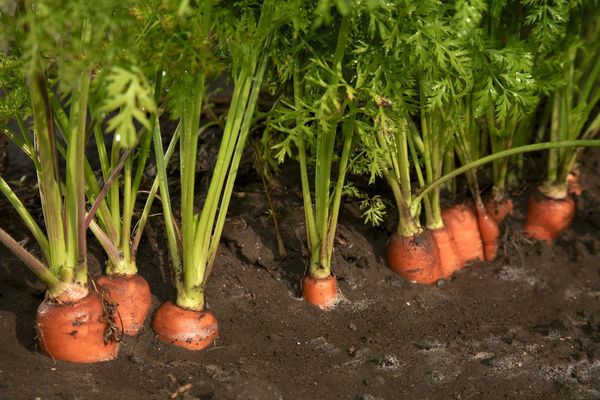

The best crop to plant after strawberries is carrots.
She is not afraid of dangerous pests that adversely affect berry bushes. This is due to the fact that the roots of such crops can assimilate nitrogen from the air.
It turns out that they do not "pull" a component important for their development from the soil. In addition, legumes are involved in soil saturation with useful elements... By planting such plants after strawberries, you will not only get a good harvest on weak soil, but also prepare the garden for growing other plants.
There is an opinion that they grow well on the former strawberry plantings cucumbers, melons, zucchini and other melons and gourds. Such a crop rotation is possible if the land is pre-cultivated and fertilizers are added to it.
Recommended in the first season after planting strawberries garlicwhich has antifungal and antimicrobial properties and repels harmful parasites. The aisles are used for celery and parsley, which scare away slugs - frequent residents of strawberry beds.
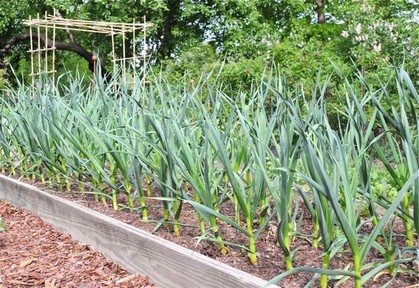

In the first season after strawberries, it is recommended to plant garlic
It has been proven in practice that the quality of the soil after the predecessor can be improved by planting certain types of flowers on the site. It can be tulips, peonies, garden violetse. And if there are opportunities and a sufficient area of the garden, break flower beds in such a place.
Read also: Tomato Yamal: characteristics and description of the variety
The best neighbors, what to plant nearby?
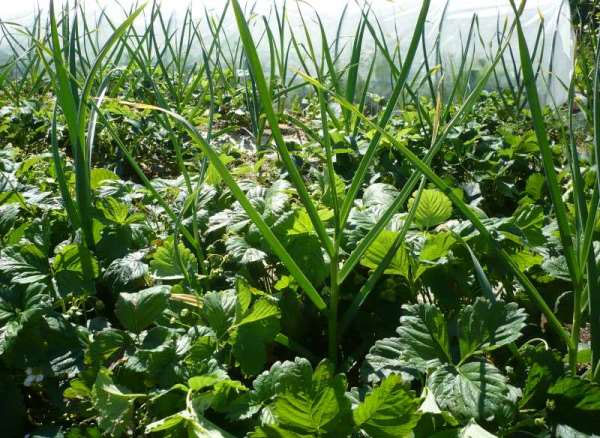

If the strawberries are not planted with a solid carpet, it is quite possible to add useful "neighbors" to it on the garden bed. When the bushes grow in a checkerboard pattern, there is a free space between them, where you can arrange plantings of lettuce and spinach. This technique will allow more rational use of the land.
- If you use parsley instead of lettuce and spinach, strawberry bushes are guaranteed protection from slugs, which do not like fragrant greens.
- Onions and garlic planted between the bushes will protect the berries from the nematode, and they themselves will grow large heads, so that the benefits of such a neighborhood will be mutual.
- Low-growing varieties of marigolds, which will not be able to shade berry bushes, will also help to rid strawberries from nematodes.
- Linear planting of strawberries can be alternated with rows of carrots, radishes, radishes, beets, herbs, garlic and onions.
- Beans, peas and lentils are perfect neighbors.
On a note! Not suitable for the neighborhood with strawberry bushes fennel, horseradish and wild strawberries.
Soil restoration
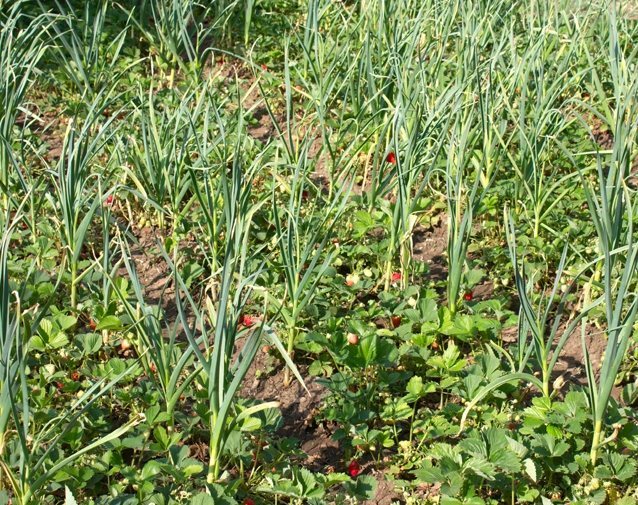

For growing strawberries, sandy loam and loamy soils, as well as black soil, will be most suitable. The preferred soil acidity index is 4.5-5.5 pH. The land should have good water and air permeability, high fertility.
Strawberries grow poorly in depleted calcareous and saline soils. Before planting berries, organic and mineral fertilizers must be applied to the ground. If the soil on the site is not suitable, it can be improved:
- Clay or sapropel must be added to sandy soil. The additives will add viscosity so that the soil can retain moisture and fertilizer.
- If the site is clay, on the contrary, sand is added. This is necessary in order for the soil to become looser. Clay soil also needs liming, but lime is applied 3 years before planting strawberries.
- Alkaline and waterlogged soils are categorically unsuitable for growing strawberries, as they require dramatic improvement.
We suggest that you familiarize yourself with: How many bugs live after disinfection
The preparation of the soil begins at the end of the previous season. For organic enrichment, humus or compost is used. Fertilizer is applied during the digging of the site to a depth of 30 cm. Additional superphosphate (35 g) and potassium chloride (20 g) are used.
On a note! To increase the fertility of the soil, green manure plants can be sown as a precursor in the fall, which at the same time improves the structure of the soil.
The crop also needs to be fed regularly during cultivation. To get rid of the causative agents of fungal diseases, before planting, the holes are spilled with a solution of nitrophene or ferrous sulfate. As a prevention of gray spot, the soil is treated with a solution of calcium chloride.
In order to restore the soil after all the plants, it is advisable to plant green manures on the site in the first year.
To enrich the soil with potassium, you need to plant white mustard, phosphorus can be obtained from buckwheat.
In order not to resort to oversaturation of the soil with fertilizers to increase the yield, you can use green manure. For strawberries, lupine is the best green manure.
As stated, with some crops, strawberries thrive and grow better than alone. Such plants include peas, beans, soybeans, they provide nitrogen to the soil.
Phacelia and lupine also belong to siderates. They will also provide the strawberries with shade for protection on hot days, while the roots loosen the soil. Good neighbors for strawberries also include sage, cucumber herb.
What is better to grow on a bed freed from strawberries
- As professional gardeners assure, the best option, in this case, is carrots. And this is due to the fact that, firstly, carrots do not get sick with the diseases that strawberries are susceptible to, which means they cannot get infected in the garden. Secondly, carrots take nitrogen not only from the soil, but also from the air, so the land depleted by strawberries is not afraid of it.
- Melons take root well on the beds left by strawberries. But, nevertheless, before planting them, the soil needs fertilization.
- Legumes take root well in a strawberry garden, moreover, they supply the soil with nitrogen in such an amount that after the season of their stay in the garden, any plants can then be planted in the soil.
- Planting cauliflower or white cabbage in place of strawberries is possible, but then the soil needs nitrogen fertilization.
- Strawberry beds need decontamination, so planting garlic is another option that will help kill two birds with one stone. This herb has strong anti-fungal and antibacterial properties.
- Flowers also easily take root in former strawberry beds. Therefore, at the same time, you can also decorate your garden.
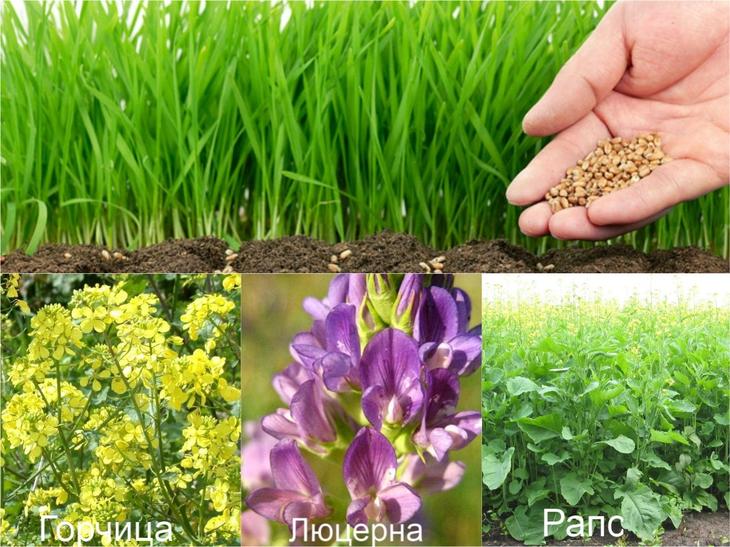

Popular strawberry variety
Among the many varieties, the most delicious and largest berry is distinguished, the variety of which is called Victoria. She received the name from the Queen of England. Gardeners who like to experiment in their beds can grow an excellent harvest.
The weight of one berry reaches 75 grams, which distinguishes Victoria among other varieties of strawberries. The berry has a sweet taste with a slight sourness. In one season, a strawberry bush gives two harvests, while the fruits of the second harvest are larger than the first.
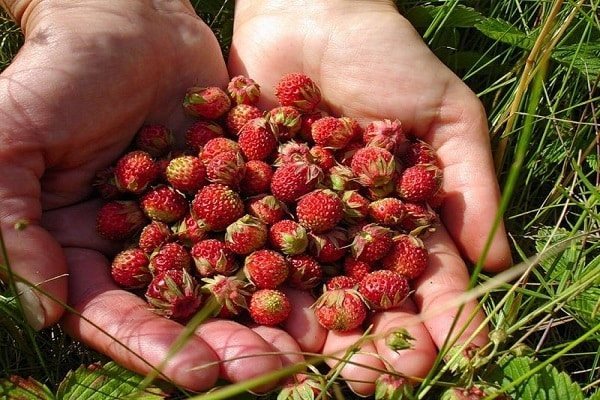

If you are tired of growing the same strawberry variety, then you can plant Victoria strawberry, it will adequately replace the usual berry for several seasons.
So, we learned that garlic is a very healthy crop. It can be planted before planting strawberries and planted side by side. In this case, the soil in the garden will only improve.


Decorative varieties of remontant strawberries
Recently, the selection of remontant strawberries with very attractive red, raspberry or pink flowers has been especially intensive.It is called a neutral daylight garden strawberry and is considered an ornamental plant that can grow in partial shade despite its great taste. Such strawberries are eaten and used to decorate flower beds, rockeries and slides. It is even planted in flowerpots, and sometimes in tree trunks as a cover plant.


You need to know that strawberries will not do well next to a birch tree. But next to the following plants it will grow great:
- pines and firs;
- ferns;
- spireas;
- irises.
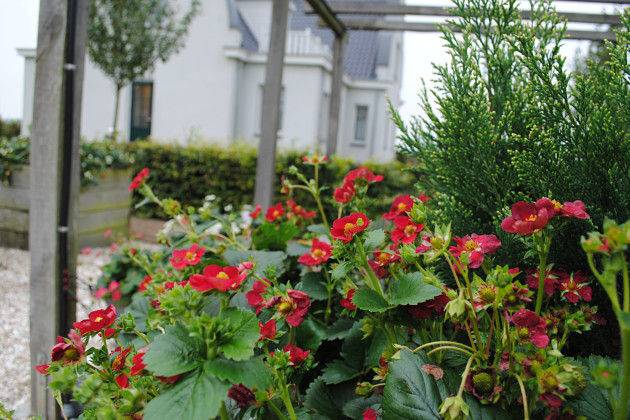

Remember the basic rules of crop rotation
- Remember that the same crop in a permanent place unilaterally depletes the soil... Favorable conditions appear for the development of diseases and insect pest increases.
- Move crops around the garden... But to do this, alternating plants by belonging to families, the depth of the root system. The process will reduce the amount of applied fertilizers, reduce the level of pests without the use of pesticides.
- Consider the attitude of plants to manure and lime. The components change the composition of the soil. A crop that grows well in a manure bed will reduce yields when transplanted to a site without organic additives.
- Know the best predecessors and followers for all cultivated plants. These are siderates.
After what time can you plant
After culture allowed
If the rules of crop rotation do not interfere with planting, then after the permitted type of vegetables, garlic can be planted in the next season - or even the same when it comes to growing winter garlic.
After the forbidden culture
In the event that the predecessor vegetable is not recommended for crop rotation, you should wait at least a year - and try to grow something more suitable for garlic in its place. However, you should keep in mind the following:
- If the next crop is also not recommended for planting before garlic, you should wait another year.
- Some pests (for example, rot pathogens) can persist in the soil for decades. Therefore, some plots should be removed from the rotation of garlic and left for other crops.
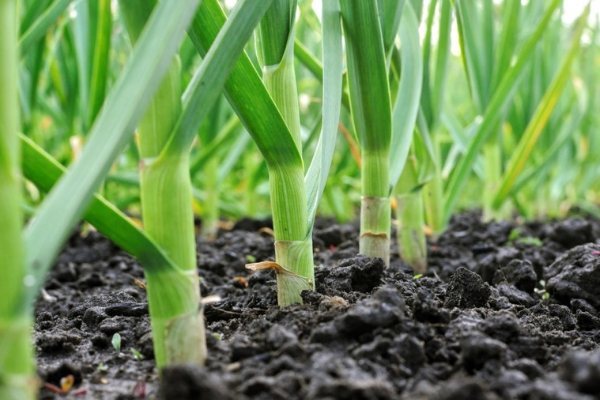

Growing garlic requires taking into account not only the conditions on a particular plot - but also the predecessor plants. If the predecessor is not suitable, you should refrain from cultivating garlic.
If you find an error, please select a piece of text and press Ctrl + Enter.
We tried to write the best article. If you liked it, please share it with your friends or leave your comment below. Thank you! Excellent article 2
Features of crop rotation in strawberry beds
Strawberries bear fruit well in the second and third years of their growth in one place. Further planting should be rejuvenated by changing the place for the berries. For this process to be most productive, it is important to comply with the requirements of crop rotation standards. It is often not possible to carry out a full crop rotation in a small area, but it is advisable to apply at least the simplest rule: do not plant crops with the same productive area after each other, i.e. berry crops after berry, leaf after leaf, etc.
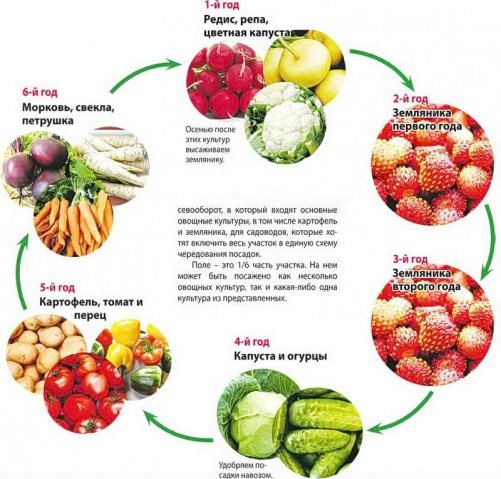

Immediately after strawberries, it is important not to plant crops with a similar productive area.
If the strawberries, from which you decided to free the garden, were already bearing poor fruit, then it is better to simply burn the dug out bushes, dig up the earth to a depth of two shovels with bayonets and treat the soil with herbicides.
If the area permits, then such a site is best left "fallow" for a year to restore the soil. In this case, the site is dug up several times, organic substances and mineral additives are introduced and left to rest for a year without planting.
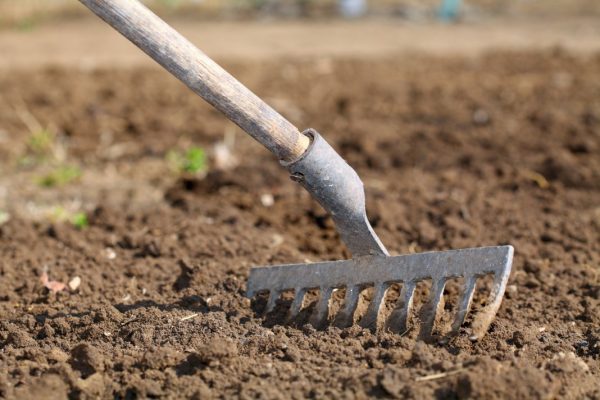

In order for the land to rest after strawberries, it would be good to leave the site for a year "under steam"
What to plant after strawberries
Leaving a summer cottage "under steam" on six acres is often simply impossible, so you have to look for the most advantageous replacement. Gardeners with experience assure that root crops are the first. And one of the best among them is carrots. Other options include:
- greens,
- onion,
- cabbage,
- leafy vegetables,
- legumes,
- bulbous crops, including flowers.


Among the "post-strawberry" crops are root crops, green manure and bulbous
Still, one of the most reasonable options for restoring soil after strawberries is planting green manure. These can be different legumes:


Legumes planted after strawberries will replenish nitrogen reserves in the soil
In addition to legumes, as siderates in the same season can be sown:
What can be rooted in place of strawberries for the second season
From the second year, in place of garden strawberries, you can plant:
- any cabbage crops - radish, radish, cabbage, turnip, etc.;
- corn;
- nightshade - tomatoes, eggplants, potatoes;
- beets;
- pumpkin crops - cucumbers or pumpkin, as well as zucchini, squash.
These garden plants will be able to please with a normal harvest and at the same time restore the structure and microflora of the soil. Planting in the second season of rye, oats or barley is also practiced. Cereals will serve as green manure plants.
After which you should not plant strawberries
It is undesirable to plant after crops prone to stem nematode damage:
- cucumbers,
- cabbage,
- representatives of the aster family - asters, leaf and cyclic salads, tarragon,
- buttercup - nigella.
Plants that have common diseases and pests with strawberries will become bad predecessors:
- nightshades - potatoes, tomatoes, peppers, eggplants,
- rosaceous.
It is also undesirable to plant garden strawberries after stubbing perennial plantings of raspberries, currants, stone fruits - this can contribute to the development of rot.
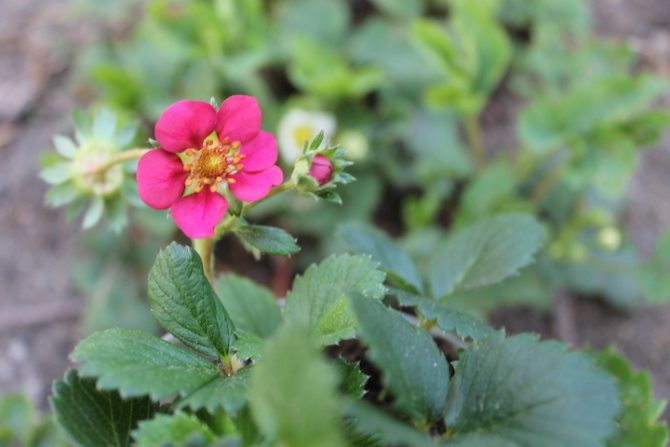

Where to buy seeds and seedlings with delivery


The Scientific and Production Association "Sady Rossii" has been introducing the latest achievements in the selection of vegetable, fruit, berry and ornamental crops into the wide practice of amateur gardening for 30 years.
The work of the association uses the most modern technologies. A unique laboratory for microclonal reproduction of plants has been created.
The main task of NPO Sady Rossii is to provide gardeners with high-quality planting material. The most popular varieties of various garden plants and novelties of world selection. Delivery of planting material (seeds, bulbs, seedlings) is carried out by Russian post.
We are waiting for you for shopping at the NPO Sady Rossii. Did you like the article? Share with your friends on social networks:
What Science Says


From a scientific point of view, garlic and strawberries are considered to be well compatible plants. But science claims that to establish the truth, you need to observe the purity of the experiment.
We invite you to familiarize yourself with: Fast cabbage pickled with hot brine


It all depends on how to land. Garlic with strawberries can be planted:
- Joint planting (since many novice vegetable growers plant, who afterwards, remain disappointed), plant the garlic between the bushes.
- Using crop rotation.
Allelopathy
According to research, plants have:
- direct impact, in the immediate vicinity due to the secretions of both the root system and the leaf apparatus. Plants emit volatile substances, aromatic, water-soluble, which are washed off by rainwater and the neighbor, due to the fact that there is nowhere to run, consumes them. Such substances can be both stimulants and growth inhibitors;
- indirect impact is through the soil. The roots secrete organic compounds, the total mass of which is up to 10%.The study of the chemical nature of these compounds is ongoing. They are not the same in composition and properties, and are sometimes toxic. It is this effect that underlies crop rotations and determines the alternation of crops in it.
Choosing a landing site
Strawberry is a thermophilic plant, so the place of its growth should be located in a well-heated area, protected from strong gusts of cold wind and sufficiently illuminated by the sun's rays. The optimal type of substrate is a slightly acidic or neutral soil of a medium loamy or sandy loam type.
Heavy clayey soils will not work, so in the absence of an acceptable alternative, you will have to organize artificial earth embankments from a suitable substrate. It is advisable to add mineral compositions and peat to depleted soils, evenly distributing them throughout the entire thickness of the soil.
Did you know? Strawberry juice performs all the functions of a whitening toothpaste, therefore, to whiten the enamel of your teeth, you just need to slowly chew the berries, eating 3-4 pieces at a time.
Berry seedlings are usually planted at a distance of 30–40 cm in a row and 50 cm in aisles, therefore, according to this scheme, holes for young plants can be marked. Upon completion of planting, the plants need to be watered well again and, if necessary, mulched with a layer of peat or sawdust.
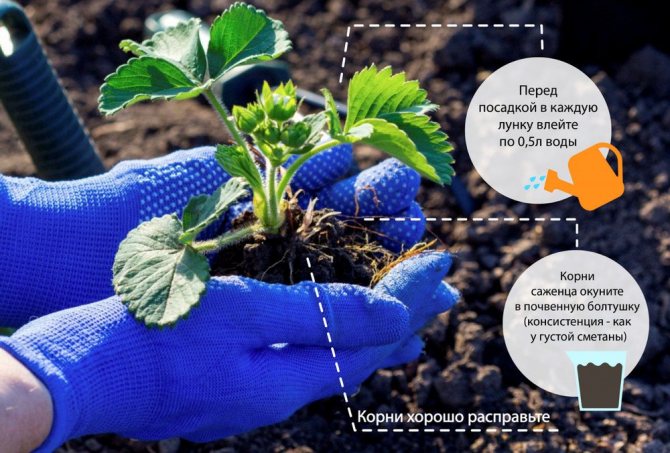

Is there a difference in the predecessors for the winter and spring varieties?
There are two main types of cultivars:
- Winter - planted in late autumn, winters under the snow, develops from spring to summer.
- Spring - planted in early spring, ripens by autumn.
Despite the difference in cultivation, biologically, both spring and winter root crops are representatives of the same species. Accordingly, they consume the same nutrients, suffer from the same diseases and parasites. Consequently, there will be practically no difference in their predecessors. Maximum - the difference in planting dates:
- Winter crops can be planted after the predecessor vegetables have been harvested, and the garden bed has been dug up, fertilized and acid-stabilized by adding lime.
- The planting of the spring plant depends on the activities undertaken in the fall.


It is also important to know what to plant after garlic in the fall.
What plants are not recommended to be planted in the garden where strawberries used to grow
Planting raspberries on a former strawberry garden is contraindicated, since this plant simply does not have enough nutrients from the soil, which is pretty depleted. In addition, the diseases in these plants are the same. This increases the likelihood of raspberry infestation.
Read also: Sweet cherry of Milan: description of the variety, photos, reviews
There are a number of plants that can be planted on an empty garden bed, but it is better to do this a year after fertilization has been applied to the soil. These are plants such as:
- Potatoes, strawberries and tomatoes, just like raspberries, are susceptible to disease and attack of the same harmful insects as strawberries. Based on this, experienced gardeners highly discourage planting these plants on the vacant garden bed.
- Planting radishes and bell peppers is possible, but undesirable, since these plants, being in the former strawberry garden, will change their taste for the worse.



